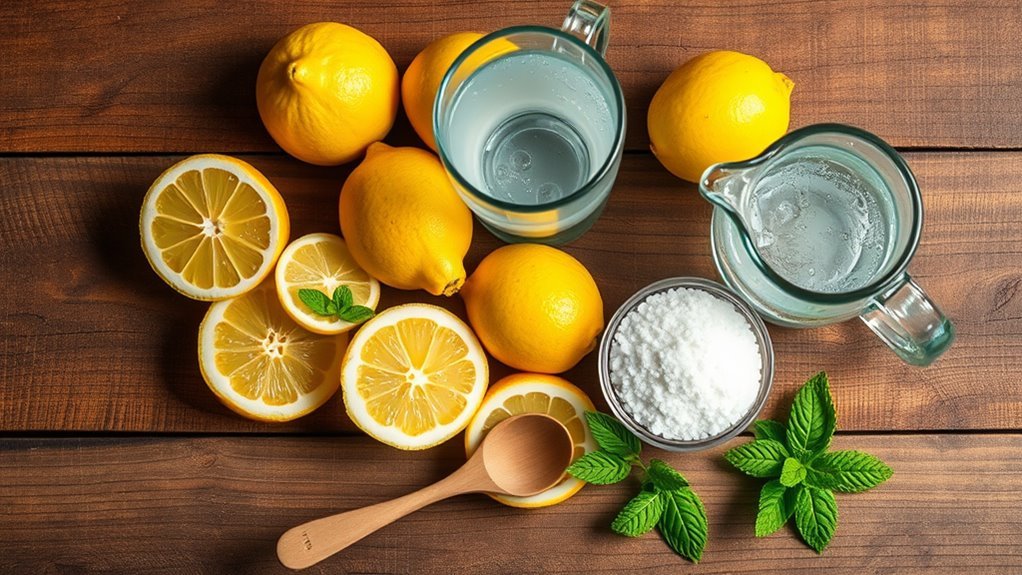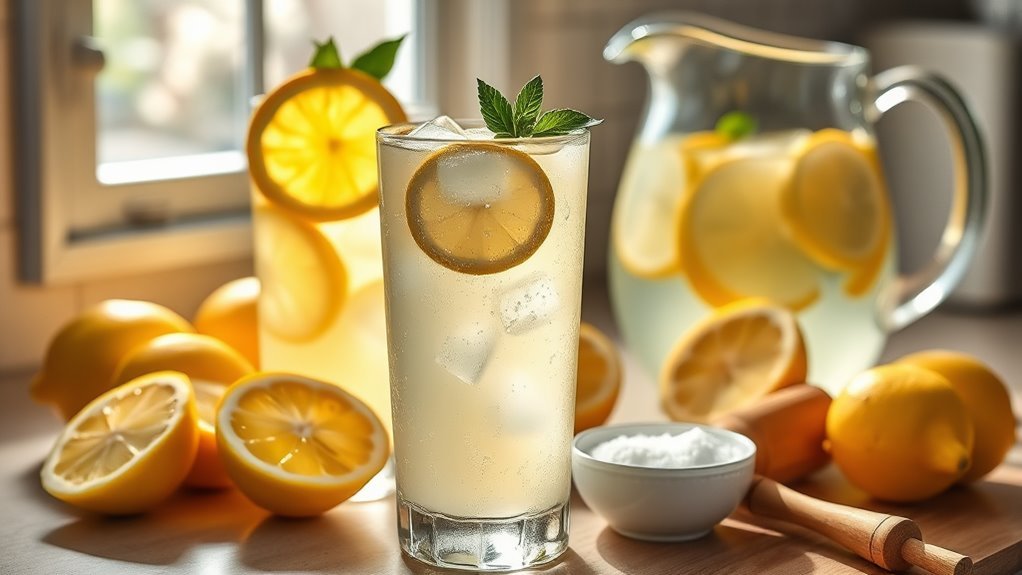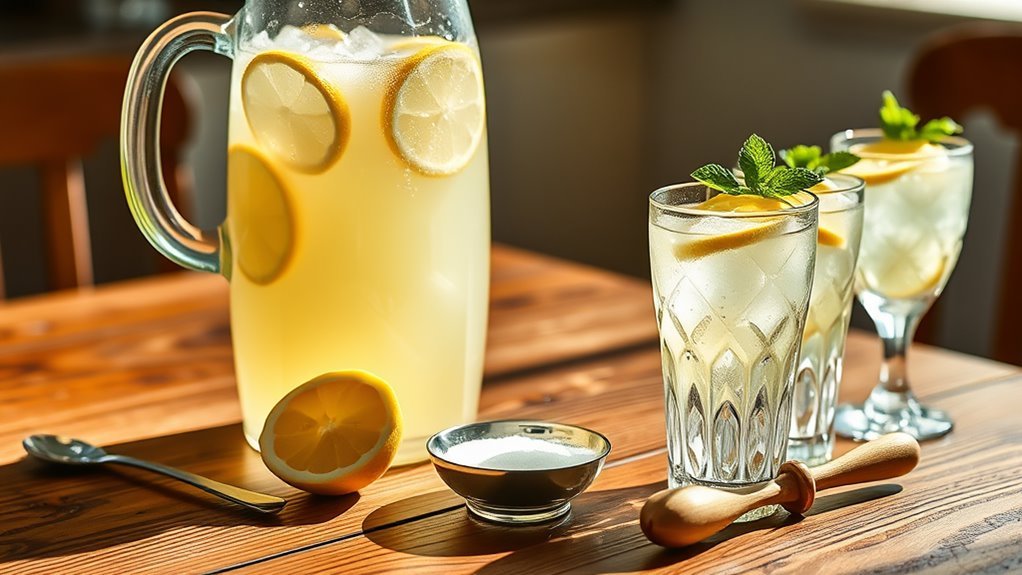Alright, let’s dive into the world of classic lemonade. You know, this isn’t just any old drink; it’s the kind of refreshment that brings back memories of summer picnics and lazy afternoons. We’re talking about that perfect blend of sweet and tangy that dances on your taste buds, all thanks to three simple ingredients: lemons, sugar, and water.
Now, I’ll be the first to tell you that making lemonade isn’t rocket science. It’s more about finding that sweet spot where the tartness of the lemons meets the sugar just right. We’ll chat about the best techniques to get the most juice out of those lemons and how to mix it all together without any fuss.
And don’t think for a second that this drink is just for hot days. It has roots that go way back, and it’s evolved along the way, giving us plenty of room to play around with flavors. But at the heart of it all, classic lemonade remains a timeless staple. So grab your lemons, and let’s get to squeezing!
Ingredients

Fresh lemonade is built on three fundamental ingredients that create its signature sweet-tart refreshment: freshly squeezed lemon juice, granulated sugar, and cold water. While the basic recipe remains consistent across sources, the ratios can vary considerably depending on desired sweetness and concentration, with typical recipes calling for 6-12 lemons yielding 1-2 cups of juice, combined with ½ to 1 cup of sugar and 3-6 cups of water. For maximum juice extraction, roll lemons firmly on the countertop before cutting and squeezing them. Optional ingredients like fresh lemon slices, mint leaves, or cherries can be added for garnish, while some variations incorporate a pinch of salt to enhance the overall flavor profile.
| Ingredient | Amount | Notes |
|---|---|---|
| Lemons | 6-12 | Yields 1-2 cups juice |
| Granulated Sugar | ½-1 cup | Adjust to taste |
| Cold Water | 3-6 cups | Based on desired strength |
| Ice Cubes | As needed | For serving |
| Lemon Slices | Optional | For garnish |
| Salt | Pinch | Optional flavor enhancer |
Recipe

Making classic lemonade is a revitalizing process that combines the perfect balance of sweet and tart flavors. The key to great lemonade lies in achieving the right ratio of lemon juice, sugar, and water, while guaranteeing the sugar completely dissolves for a smooth drinking experience. This beloved drink is versatile for pairing with iced tea to create an Arnold Palmer.
This timeless beverage can be prepared using several methods, from the simple cold-mixing technique to the more traditional heated syrup approach. While both methods yield delicious results, the heated syrup method guarantees better sugar dissolution and produces a more consistent flavor throughout the drink.
Mix 1 cup of sugar with 1 cup of water in a saucepan over medium heat, stirring until the sugar dissolves completely to create a simple syrup. While the syrup cools, juice the lemons to yield approximately 1 cup of juice, straining out seeds and pulp. Combine the cooled simple syrup with the lemon juice in a pitcher, then add the remaining 5 cups of water. Stir thoroughly and adjust sweetness or tartness to taste by adding more water or sugar as needed. Chill thoroughly before serving over ice.
For best results, use fresh lemons at room temperature and roll them on the counter before juicing to release more juice. If using the cold method, warm water will help dissolve the sugar more efficiently. Consider making extra simple syrup to store in the refrigerator for quick lemonade preparation in the future. Remember that lemonade will taste slightly less sweet when cold, so make it a touch sweeter than desired at room temperature.
Mixology Guide

While classic lemonade is delightful on its own, mastering mixology techniques can elevate this beloved drink into something extraordinary. Understanding your personal taste preferences will help guide your recipe adjustments for the perfect balance.
Simple lemonade transforms into an artisanal experience through the precise techniques of modern mixology.
We’ll show you how to transform your lemonade into a sophisticated beverage using professional methods:
- Create oleo saccharum by steeping lemon peels in sugar to extract intense citrus oils.
- Perfect the sweet-sour balance by carefully measuring your sugar syrup (2:1 ratio) and fresh lemon juice.
- Muddle citrus slices gently to release essential oils and maximize flavor.
- Shake with ice and strain for ideal clarity, then top with soda water for the perfect effervescence.
These techniques will help you craft restaurant-quality lemonade every time!
History

The rich history of lemonade stretches back over a millennium, with its earliest documented origins tracing to 10th-century Egypt.
We can trace its humble beginnings to kashkab, a fascinating fermented drink made from barley and lemons that was popular in medieval Egyptian markets.
As Arabic traders spread this invigorating beverage across the Mediterranean, it evolved from a medicinal remedy into a luxury drink for European elites. By the 17th century, the widespread availability of lemons and sugar made lemonade accessible to common people across Europe.
Final Thoughts

From its ancient Egyptian roots to today’s diverse marketplace, lemonade has evolved into much more than a simple mixture of lemons, water, and sugar.
Today’s options reflect our modern lifestyle and health consciousness:
- Traditional recipes like Chick-fil-A’s pure cane sugar blend offer that classic taste we’ve grown to love.
- Health-focused varieties like Team Ready provide electrolytes and vitamins for active individuals.
- Sugar-free alternatives and customization options let us control our calorie intake.
- Specialty blends featuring natural fruit sources and enhanced nutrients show how far we’ve come in reimagining this timeless beverage.
To better understand consumer preferences, companies use site interaction data to develop new lemonade varieties that match evolving tastes.
We’re excited to see what innovations the future holds for this beloved drink.

